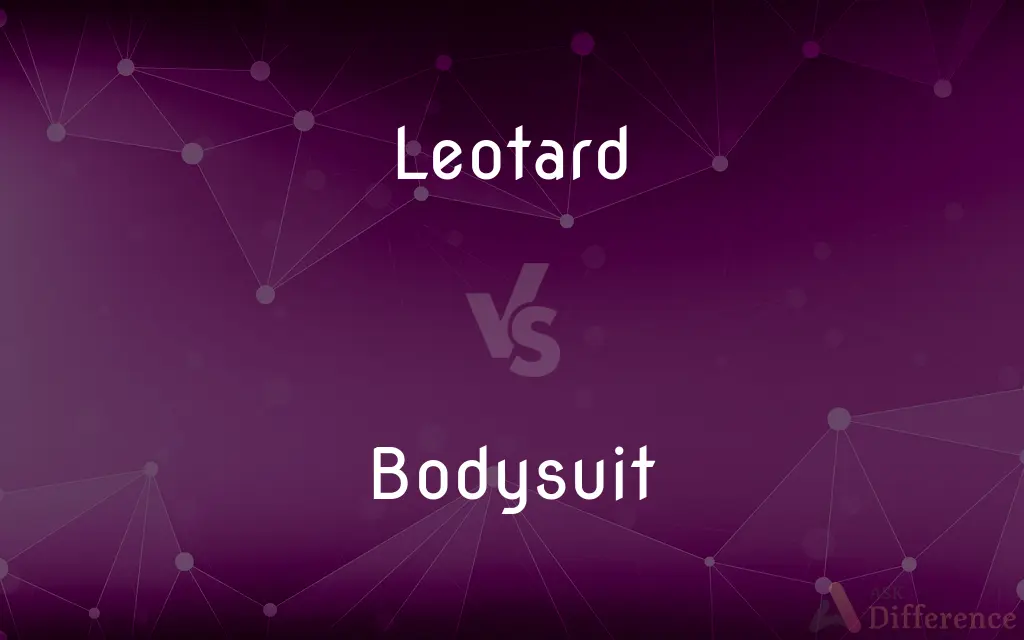Leotard vs. Bodysuit — What's the Difference?
By Fiza Rafique & Urooj Arif — Updated on March 14, 2024
A leotard is a tight-fitting one-piece garment, often used in dance and gymnastics, focusing on flexibility, while a bodysuit is similar but designed for general fashion or athletics, including snaps at the crotch.

Difference Between Leotard and Bodysuit
Table of Contents
ADVERTISEMENT
Key Differences
A leotard is a skin-tight, one-piece garment that covers the torso but leaves the legs free, primarily used in dance, gymnastics, and acrobatics to allow for unrestricted movement. On the other hand, a bodysuit is a versatile garment that resembles a leotard but includes closures at the crotch, making it more practical for everyday wear or under other clothing as a layering piece.
Leotards often feature various back and sleeve designs to accommodate the aesthetics of performances and competitions, emphasizing artistic expression and functionality in physically demanding activities. Whereas bodysuits may come in a wider range of styles, including casual, formal, and athletic, designed to seamlessly integrate with fashion ensembles.
Material-wise, leotards are usually made from stretchable, durable fabrics like spandex or lycra to withstand the rigors of performance, focusing on support and comfort during high-intensity activities. Bodysuits, while also stretchy, can be found in a broader spectrum of materials, from cotton blends to lace, catering to both comfort and fashion needs.
In terms of use, leotards are a staple in the wardrobes of dancers, gymnasts, and athletes, where the garment’s design maximizes range of motion and performance. Bodysuits are embraced by a wider audience, serving not only as athletic wear but also as a fashion item that can be styled with jeans, skirts, and trousers for a sleek, tucked-in look.
Despite their similarities, the primary distinction lies in their intended use and design specifics, with leotards focusing on the needs of performers and athletes, and bodysuits offering a blend of functionality and style for everyday wear.
ADVERTISEMENT
Comparison Chart
Primary Use
Dance, gymnastics, and athletics.
Fashion, layering, and casual wear.
Design
No closures, designed for performance.
Includes snaps at the crotch for convenience.
Material
Spandex, lycra, and other stretch fabrics.
Wide range, including cotton, lace, and spandex.
Sleeve/Back
Varied designs for artistic or performance needs.
Fashion-forward styles, including long sleeves, tank tops, and more.
Functionality
Maximizes flexibility and range of motion.
Versatile, can be worn as outerwear or underwear.
Compare with Definitions
Leotard
Comes in various back and sleeve styles to suit performance requirements.
The aerobics instructor wore a sleeveless leotard with a scoop back.
Bodysuit
A one-piece form-fitting garment that includes closures at the crotch for practicality.
She paired her high-waisted jeans with a sleek bodysuit.
Leotard
Made from materials that support high-intensity activities.
Her leotard, made of durable spandex, endured through the competition.
Bodysuit
Can be styled with various bottoms for a seamless look.
The fashion blogger showed how to style a bodysuit with skirts and trousers for a chic look.
Leotard
Focused on providing unrestricted movement for physical activities.
Gymnasts choose leotards that offer flexibility for their routines.
Bodysuit
Designed to be worn as both outerwear and underwear.
The athlete wore a moisture-wicking bodysuit under her uniform for comfort.
Leotard
A form-fitting garment designed to cover the body while leaving the legs free, often used by dancers.
She wore a black leotard for her ballet performance.
Bodysuit
Available in a variety of materials to match different styles.
Her lace bodysuit added a touch of elegance to her evening outfit.
Leotard
Essential for performers and athletes for its functionality.
The ice skater's leotard was both functional and beautifully designed.
Bodysuit
Offers versatility in fashion, from casual to formal wear.
For the office, she chose a bodysuit with a blazer and pencil skirt.
Leotard
A snugly fitting, stretchable one-piece garment with or without sleeves that covers the torso, worn especially by dancers, gymnasts, acrobats, and those engaging in exercise workouts.
Bodysuit
A bodysuit is a one-piece form-fitting or skin-tight garment that covers the torso and the crotch, and sometimes the legs, hands, and feet, and cannot be used as a swimsuit. The style of a basic bodysuit is similar to a one-piece swimsuit and a leotard, though the materials may vary.
Leotard
A one-piece skintight garment with or without sleeves and without legs (often worn by gymnasts, acrobats, wrestlers, female swimmers, etc.)
Bodysuit
A tight-fitting one-piece garment for the torso.
Leotard
A tight-fitting garment of stretchy material that covers the body from the shoulders to the thighs (and may have long sleeves or legs reaching down to the ankles); worn by ballet dancers and acrobats for practice or performance
Bodysuit
A similar garment that covers all or most of the body.
Bodysuit
A one-piece, skin-tight garment rather like a leotard.
Common Curiosities
Why do leotards not have snaps at the crotch?
To ensure comfort and avoid disruptions during performances and physical activities, leotards typically do not include crotch snaps.
Are bodysuits suitable for workouts?
Yes, certain bodysuits are designed for athletic purposes, offering both support and style during workouts.
How does a bodysuit differ from a leotard?
A bodysuit is similar to a leotard but includes practical closures at the crotch and is designed for broader fashion or athletic use.
Can leotards be worn as everyday clothing?
While primarily designed for performance, leotards can be styled for everyday wear, especially in artistic or casual settings.
Do leotards come in different styles?
Yes, leotards are available in various designs, including differences in sleeves, backs, and necklines, to meet the aesthetic and functional needs of performers.
What is a leotard?
A snug one-piece garment designed for dancers, gymnasts, and athletes, emphasizing flexibility and motion.
Are bodysuits comfortable for long-term wear?
With the right fit and material, bodysuits can be comfortable for all-day wear, offering a seamless look under clothes.
Is there a difference in the material used for leotards and bodysuits?
Yes, while both may use stretchy materials like spandex, bodysuits also come in a wider variety of fabrics, including cotton and lace, for different occasions.
How should one choose between a leotard and a bodysuit?
The choice depends on the intended use: a leotard for performance and athletic activities, and a bodysuit for fashion versatility and everyday wear.
Can bodysuits be worn under other clothes?
Absolutely, bodysuits are often used as a smooth, tucked-in layer under other clothing for a sleek silhouette.
How do dancers choose their leotards?
Dancers select leotards based on the requirements of their performance, comfort, and the style that best expresses the artistic intention of their dance piece.
Share Your Discovery

Previous Comparison
What vs. Why
Next Comparison
Pig vs. PeccaryAuthor Spotlight
Written by
Fiza RafiqueFiza Rafique is a skilled content writer at AskDifference.com, where she meticulously refines and enhances written pieces. Drawing from her vast editorial expertise, Fiza ensures clarity, accuracy, and precision in every article. Passionate about language, she continually seeks to elevate the quality of content for readers worldwide.
Co-written by
Urooj ArifUrooj is a skilled content writer at Ask Difference, known for her exceptional ability to simplify complex topics into engaging and informative content. With a passion for research and a flair for clear, concise writing, she consistently delivers articles that resonate with our diverse audience.
















































